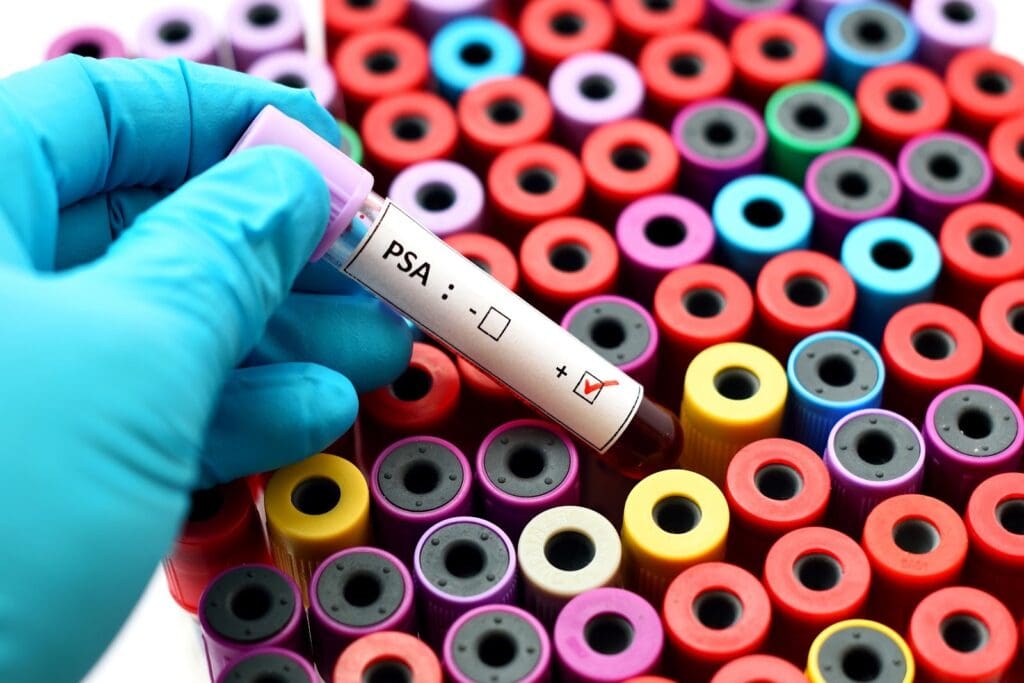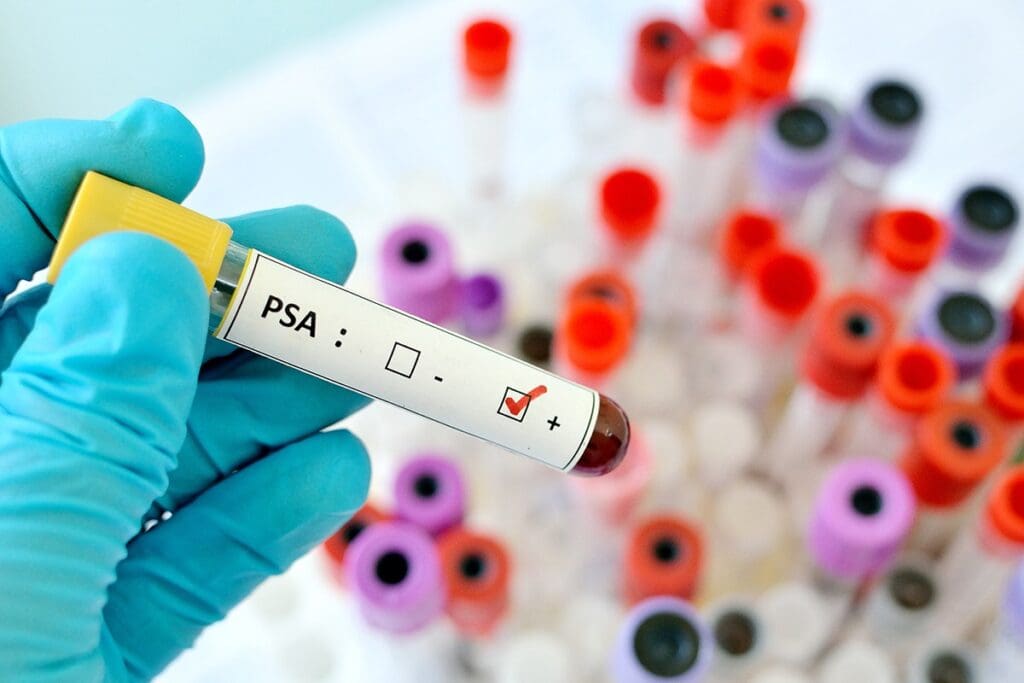Last Updated on October 31, 2025 by
Recent studies have found that PSA (prostate-specific antigen) levels change throughout the day. They show that PSA levels are usually higher in the morning than in the afternoon. A 2019 study with 190 men found a big drop in PSA levels after 3 PM.

This change isn’t surprising. Other health issues, like psoriatic arthritis, also show daily changes. These changes are important to know for accurate tests and diagnosis of prostate cancer.
Prostate-Specific Antigen (PSA) is a protein made by the prostate gland. It helps us understand prostate health. Knowing about PSA and its changes is key for spotting prostate cancer early.
PSA is a protein made by the prostate gland. It’s important for semen liquefaction. High PSA levels might mean prostate cancer, but can also show other issues like prostatitis or BPH.
PSA’s role in the body is complex. Its blood levels are a valuable tool for spotting prostate problems. But, we need to understand many factors that affect its levels.
PSA levels are checked with a blood test, called a PSA test. This test shows how much PSA is in the blood, in nanograms per milliliter (ng/mL). The test helps doctors check for prostate cancer risk and track its progress.
Key aspects of PSA measurement include:
Many things can affect PSA readings. It’s important to think about these when looking at test results. Some factors include:
Research shows PSA levels can change throughout the day, like other biomarkers. A 2019 study with 190 men found that PSA levels drop in the afternoon. This suggests that when to test PSA might be important for cancer screening.

The body’s circadian rhythm affects many processes, including inflammation in Psoriatic Arthritis (PsA). Changes in this rhythm can make PsA symptoms worse. Understanding PSA’s daily changes can help find the best time for testing.
“The circadian rhythm’s influence on biomarkers like PSA shows how complex these tests are. As we learn more about daily changes in the body, we can improve disease screening and management.”
Studies have shown that PSA levels might peak in the morning. This is not just for PSA; many body processes have daily cycles. For example, conditions like psoriatic arthritis can make leg pain worse at night, just like some biomarkers.

Research on PSA levels’ daily changes has found interesting facts. It shows that PSA levels can change a lot from morning to evening. This could change how we screen for prostate cancer.
A study found that men with high morning PSA levels often saw them drop in the afternoon. This big change could affect how doctors make decisions.
A 2019 study with 190 men found that PSA levels are highest in the morning. This study helps us understand how PSA levels change during the day. It suggests that testing in the morning might give higher results.
Managing conditions like psoriatic arthritis can also affect health and biomarkers. Techniques like relaxation and better sleep can help manage symptoms and improve sleep.
Knowing how PSA levels change during the day helps doctors make better choices about when to test. This can make prostate cancer screening more accurate.
PSA levels change a lot during the day, making us wonder when is the best time for testing. This isn’t just about PSA; many health markers and conditions have daily cycles. Knowing why these changes happen is key for accurate diagnosis and treatment.
The reasons for PSA level changes are complex. Hormonal shifts throughout the day seem to affect PSA production. For example, how PsA medications are timed can impact symptoms, with some feeling worse at night. Understanding these mechanisms helps doctors better manage patient care.
Hormones like testosterone and cortisol play a big role in PSA level changes. Cortisol, for instance, follows a daily cycle, peaking in the morning and dropping at night. This cycle can affect PSA production.
Some key points to consider:
Many biomarkers and processes have daily cycles, like PSA. For example, some inflammatory markers and hormone levels change throughout the day. By comparing PSA to these, we can learn more about its daily changes. Liv Hospital’s high standards in patient care show the importance of understanding these variations.
When looking at PSA level changes, it’s helpful to compare them to other conditions with daily patterns. Questions like which arthritis is worse or what arthritis is worse at night can help us manage symptoms and understand our body’s natural rhythms.
When it comes to Prostate-Specific Antigen (PSA) testing, timing is everything. PSA levels can change throughout the day. Knowing these changes is key to understanding test results accurately.
When PSA tests are done, they can change the results of prostate cancer screening. A 2019 study showed that PSA levels are higher in the morning than in the afternoon. This change can affect how well screening works, mainly for men with PSA levels close to the decision point for biopsies.
The 3-4 ng/mL range is very important for deciding if a biopsy is needed. A study looked at how PSA changes during the day affect biopsy decisions. For example, a man’s PSA might be 3.5 ng/mL in the morning and 3.0 ng/mL in the afternoon. This could change whether he gets a biopsy.
People with Psoriatic Arthritis (PsA) often have trouble sleeping. This can make PSA test results harder to understand. Fixing sleep problems is important for men getting prostate cancer screening.
To reduce the effect of PSA changes on screening, it’s best to test at the same time every day. Morning tests are usually recommended because PSA levels are highest then. But comparing test results from different times needs careful thought.
By testing at the same time and considering individual differences, doctors can make prostate cancer screening more accurate. This helps them make better decisions for patient care.
Arthritis pain often gets worse at night. This makes us wonder if PSA levels follow a similar pattern. We will look into how different biological markers change throughout the day.
Many biological markers change with the day. For example, some cytokines involved in inflammation, like in arthritis, change too. Knowing these patterns can help manage symptoms and guide when to do tests.
Research shows that inflammatory markers often peak at specific times. This can make symptoms worse, like in arthritis. Even though PSA is specific to prostate health, it might follow similar patterns.
Studies on night shift workers show how disrupted rhythms affect the body. They found that night shifts can change hormone levels, including those related to the prostate. Looking into how night shifts affect PSA levels could reveal more about the connection between circadian rhythms and prostate health.
A study in a medical journal found that men working night shifts had different PSA levels than those working days. This shows a complex link between circadian rhythms, hormonal cycles, and PSA production.
Arthritis pain and PSA levels are linked to different health issues. But comparing their daily patterns can be enlightening. Arthritis pain gets worse at night due to inflammation and lower cortisol levels. PSA levels, on the other hand, are influenced by hormones and other body processes.
Understanding the differences and similarities between these markers can deepen our knowledge. This can help manage related health conditions better and guide when to do tests.
Improving sleep and managing symptoms can greatly improve life for those with Psoriatic Arthritis (PsA). Knowing how PSA levels change during the day can also help with prostate cancer screening.
Research on PSA diurnal variations is key to prostate cancer screening and diagnosis. Studies show PSA levels can change throughout the day, with peaks in the morning. Knowing these changes is vital for accurate diagnosis and treatment.
Managing conditions like psoriatic arthritis (PsA) requires a detailed approach. This includes adjusting medications, staying active, and improving sleep. People with active PsA often spend more time sitting and less time being active. This can lead to arthritis pain in the legs and affect their health.
Even though PsA and PSA levels aren’t directly linked, it’s clear that diurnal variations in biomarkers matter. A study found that a better mood was linked to more activity and less sitting. This shows how mood, activity, and disease activity are connected. It’s important when thinking about whether PsA can cause night sweats or worsen nighttime discomfort.
Yes, studies show that PSA levels can change during the day. Some research points to a morning peak.
Yes, many feel arthritis pain more at night. This isn’t directly tied to PSA changes. But both are affected by our body’s natural rhythm.
When you get a PSA test, it can change the results. Morning levels might be higher than evening ones. This can affect decisions about biopsies and cancer screening.
Knowing about PSA changes during the day is key to accurate cancer screening. Standardizing when tests are done can help reduce these effects.
Some research suggests night shifts might change PSA levels. This could be because of how our natural rhythm is disrupted.
The reasons are not fully known. Hormonal shifts, inflammation, and our natural rhythm might play a part in why pain increases at night.
PsA and PSA changes are different conditions. But both are influenced by our body’s rhythm. Managing PsA might affect sleep, which could link to PSA changes.
It’s important to standardize when PSA tests are done to reduce day-to-day changes. Research hints at morning testing being more accurate. But more studies are needed to be sure.
Subscribe to our e-newsletter to stay informed about the latest innovations in the world of health and exclusive offers!